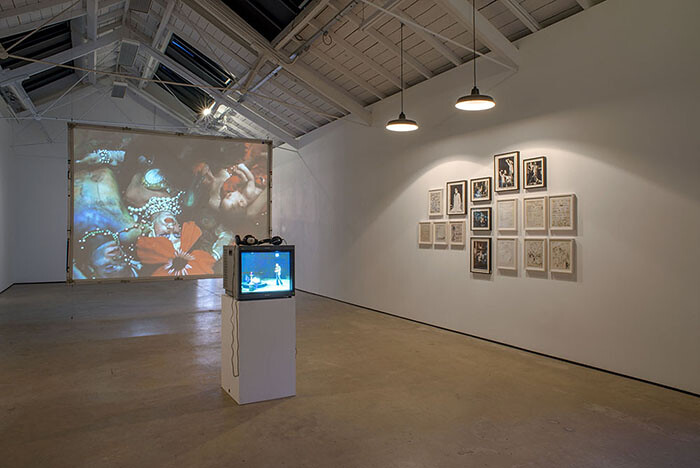Jack Smith (1932–1989) embodied a certain kind of New York—a chaotic, unpredictable, and unregulated city where creativity thrived amidst squalor and raw energy. Smith’s performances (from 1969 onwards) often took place in domestic spaces tipped towards catastrophe by his accretions of junk and debris, and by his regular assertions of his own failure. Reduced now to bare documentation, these performances are difficult to convey in their anarchic immediacy. The inevitable problems of exhibiting documentation are only enhanced by the clean, professional curation of contemporary galleries. Despite those hurdles, something shines through in this exhibition of documents related to Smith’s performance work. Perhaps Smith is just irrepressible, but the evidence presented in the drafts and fragments of his performance ephemera reveal more than might be expected.
The layout of the show anchors his work at either end of the gallery. Towards the entrance there is a large, luminous projection of Exotic Landlordism (1964–69) that blocks sight of the remainder of the works. The film has all the classic traits of a Jack Smith 16mm work, but in this context what is most important is the magnificent burst of color that confronts the eye. The sheer sensuality of the image bypasses rational consideration and the physical blaze of color defies a world made dull by art theory.
The content of the film is typical Smith—all jungle backgrounds and exotic figures—one of the pieces recently restored by filmmaker Jerry Tartaglia that may have been used within the artist’s “live film performances,” in which Smith combined reels of film and live action into a presentation for an audience. In this exhibition it works hard to establish the presence of Jack Smith amid the documentation that dominates the rest of the gallery.
At the other end of the space, however, is a dense handwritten script for a performance called Irrational Landlordism of Bagdad. Also known as Material Landlordism of Bagdad or even The Secret of the Brassiere Factory, and first performed at Cologne Art Fair in 1977, it reveals an unexpected political edge. Rooted in Smith’s eviction from a New York loft in 1971 (his “Plaster Foundation” domestic theater space), it’s one of several pieces that move from that personal experience to a wider consideration of art and capital. Smith opens the script by asking “Can art be useful?” before answering the question in this way:
“Ever since the desert drifted over the burnt out ruins of Plaster Lagoon thousands of artists have pondered and dreamed of such a thing, yet, art must not be used anymore as another elaborate means of fleeing from thinking because of the multiplying amount of information each person needs to process in order to come to any kind of decision on what kind of planet one wants to live on before business, religion, and government succeed in blowing it out of the solar system.”
Smith’s directness and his politically explicit agenda are surprising and belie the props, sparkle, and superficial exoticism of his performances. He even points to the need to freight the light vehicles of Hollywood with sharp political content: “Let art continue to be entertaining, escapist, stunning, glamorous, and NATURALISTIC - but let it also be loaded with information worked into the vapid plots of, for instance, movies.” Smith’s dream, however comically expressed, of a world “where Mario Montez and Johnny Weissmuller would labor to dissolve all national boundaries” gives the exhibition an edge that lifts it to another level. The props that sit nearby on plinths—giant costume bras, Yolanda the Penguin—suddenly seem more like relics of a strange battle against gentrification and the loss of a queered world full of political promise.
Yolanda’s magnificent presence also reminds us of Smith’s legendary spikiness: towards the end of his life, the long-suffering penguin was his only onstage companion. One small fragment of a 1983 German public broadcast documents a performance of I danced with a penguin and, humble as it is, the fragment brings Smith to life amid the debris of his props and scripts. It’s typical of the exhibition as a whole: what appears potentially superficial reveals a Jack Smith who clearly still evades adequate critical evaluation in the art world. Dominic Johnson’s 2012 book Glorious Catastrophe: Jack Smith, performance and visual culture has gone some way in signposting Smith’s performance work, but the glimpses of the material in this exhibition suggest that many dimensions of the artist still remain undiscovered.












